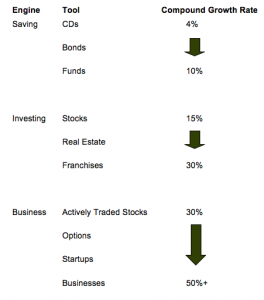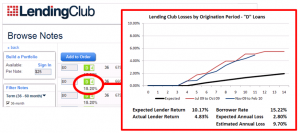
As I mentioned in my first post in this (occasional) series: “building a startup is one (highly risky) way of making $7 million in 7 years!”
My first B2B (business to business) startup was 100% offline (a.k.a. B&M a.k.a. ‘bricks and mortar); it funded my entire investment strategy – you have to get your cashflow from somewhere, right?
Even though it made barely more than a wage in terms of profits, I was able to scrimp, save, twist, and manipulate my way into an unbeatable combination of Business + Real-Estate to make my first $7 million in 7 years … even before I sold the business!
Nowadays, my twin passions come together in this post: writing about personal finance + working on startups.
I still own one fully b&m business (a finance company, established for nearly 20 years) and own 50% of another (a startup selling a unique product to cafes), but my ‘passion within a passion’ is actually web 2.0 (or, more trendily known these days as ‘social media’) startups.
And, I have just agreed terms with my two partners on my latest 100% online project (I found these guys by joining a meetup group online … kind of like meeting your future wife on PlentyOfFish.com!) .
The question that will obsess you most at this stage (it shouldn’t!) is “how much equity” did each partner get?
There’s many ways to cut-and-dice the pie:
The simplest is when two or three founders get together at a party and come up – in a flash of drunken inspiration (which is exactly how my LAST idea came to fruition) – with The Idea. Then they all do a handshake and a business is formed with each holding equal shares.
It only gets complicated – killing the business and the friendships – when one of the partners doesn’t pull their weight, or when one needs to go full-time to take the idea to the next stage, or …
The other way is to recognize different contributions at the outset:
– Who came up with the idea? Let’s say that I came up with the idea, and have begun the patent process (for whatever that’s worth).
– When did you come on board? Let’s say that I found you, and need you for a specific job (e.g. web-marketing).
– Who needs to draw a salary? Some partners will need SOME money to live … hopefully, nobody’s stupid enough to believe that this is a real, paying job (yet/ever).
– How many hours a week will each partner work? What about after launch?
– What are the basic milestones?
These are the real questions that we had to address in the past week or two, and here’s how we dealt with them [AJC: the real numbers are close to the following cooked up example]:
We agreed a NOMINAL dollar value for everything:
– The idea was given a nominal value of $200,000 (normally in the $100,000 to $200, 000) range
– It was agreed that each partner’s time pre-launch (and, to a specific point after: see milestones, below) would be worth an identical amount (we chose $100k each for the sake of simplicity; not to be confused with a real salary i.e. nobody will actually draw $100k in salary, at least not for quite a while!)
– We also agreed to keep an extra ‘salary’ for an extra partner that we would still need to find to plug a gap in our teams’ combined skill-set
– We also agreed to keep an extra few $ (initially, we wanted this to be $100,000 … we settled for less) as an extra incentive for PAID staff who may come on board in the future, but not as partners
– We also agree that we needed an ‘advisory board’ of 3 members, who would split about $35,000 in nominal ‘salary’ (remember: they will take this in % equity, not in cash!)
– We then agreed who was going to get paid in real $$$ before we actually make any money, and agreed that would be only one of the three founding partners who needed $40k to pay the bills at home! That was easily dealt with by taking down his starting position from $100k to $60k
– Finally, somebody needed to come up with some cash to start the company off (seed money); fortunately, asking me to reach into my pocket to offer $100,000 was a relatively easy decision for the group.
Now, realize that these are not real $$$ (except for the $40k salary for one of the partners and my very real $100k cash contribution) …. nobody is going to get paid $100,000! Nobody is going to give me $100,000 or $200,000 for the idea! I’m only going to put in the $100k as and when/needed!
These are NOTIONAL dollar amounts:
What we did next was to add all of these $$$$ together to come up with a single total, in this case just under $700,000.
Then it was a relatively easy matter to calculate everybody’s share of the equity e.g.:
– the founder who was not drawing a salary would receive $100,000 / $700,000 = 14% starting equity
– the founder who was drawing a $40k starting salary would receive ($100,000 – $40,000) / $700,000 = 9% starting equity
– The advisory board would split $35,000 / $700,000 = 5% (we would eventually offer 1.5% each and keep the rest as ‘spare equity’)
… and so on.
Note: whatever equity is left over (remember the ‘spare equity’ for the extra founder and for future staff incentives, plus any left over from rounding down as we did for the advisory board?) is actually owned by the founders in equal proportion to their starting equity. Equally, though, as future rounds of funding are taken on, the founders will be diluted in the same proportion.
Oh, but how do we know that we will actually work well as a team?
Simple: we didn’t hand out the equity all in one lump, we came up with a vesting arrangement tied to key business milestones.
Here’s what we came up with (each founder had exactly the same vesting arrangement, as did the advisory board, just to make sure that it didn’t cost us too much to get rid of any ‘lemons’ in our team); 20% of the offered equity would be released to each founder / advisory board member at each of the following milestones:
Milestone 1: Project Commencement (date of incorporation of (working name))
Milestone 2: Market launch of first functional web site
Milestone 3: Receipt of first substantive revenues (>$5,000 in aggregate from time of startup)
Milestone 4: Receipt of >$150,000 in aggregate revenue from time of startup
Milestone 5: Receipt of >$500,000 in aggregate revenue from time of startup
This way, everybody needs to pull their own weight until the business is truly firing on all cylinders before they ‘earn’ their full allocation of equity.
The complication will come if additional outside funding is required before these milestones are reached. Then again, if all founding partners are still on board, everyone will be affected equally (well, in proportion).
Now, why did a say this equity discussion is not important?
There’s no equity if the business doesn’t get off the ground: your prime focus, at this stage, is to make sure that you have an idea that the market wants and that you have the skills to bring to the party … and, that’s all about commitment and execution (as well as a little luck)!
If you have a startup, leave a comment to share your experience with horse trading starting equity 🙂
 What about the guy in the picture to the left? Would you go to him for advice on a healthy lifestyle?
What about the guy in the picture to the left? Would you go to him for advice on a healthy lifestyle?










